- Details
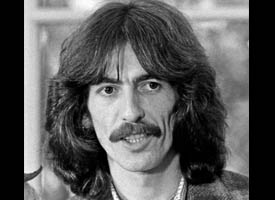 Not long after the Beatles released their first studio album, Please Please Me, Beatles guitarist George Harrison spent two weeks in Franklin County visiting his sister, Louise Caldwell, who had recently moved to Benton. While in Southern Illinois, Harrison played several impromptu gigs with local band The Four Vests, including a show at a VFW hall and a birthday party at a neighborhood bocce ball club.
Not long after the Beatles released their first studio album, Please Please Me, Beatles guitarist George Harrison spent two weeks in Franklin County visiting his sister, Louise Caldwell, who had recently moved to Benton. While in Southern Illinois, Harrison played several impromptu gigs with local band The Four Vests, including a show at a VFW hall and a birthday party at a neighborhood bocce ball club.
While Beatlemania was beginning to take hold in England, most of America at the time had little knowledge of the group. Local radio station WFRX began playing several Beatles hits while Harrison visited the area, making it one of the first American radio stations to play Beatles songs.
Louise Caldwell’s home in Benton, where Harrison stayed, was nearly demolished in the mid-1990s but saved from the wrecking ball and still stands today at 113 McCann Street.
Learn more:
Read more about George Harrison’s visit to Southern Illinois in the Illinois Times
- Details
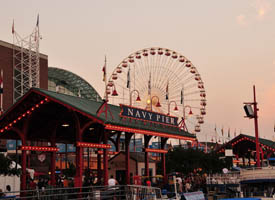 Opened in 1916 as both a shipping dock and public entertainment space, Navy Pier has evolved into one of the country’s most visited tourist destinations. Originally named “Municipal Pier,” plans for its construction were included in Daniel Burnham’s Plan of Chicago, which laid out detailed infrastructure and public works plans for the growing city.
Opened in 1916 as both a shipping dock and public entertainment space, Navy Pier has evolved into one of the country’s most visited tourist destinations. Originally named “Municipal Pier,” plans for its construction were included in Daniel Burnham’s Plan of Chicago, which laid out detailed infrastructure and public works plans for the growing city.
The pier was integral during both world wars, housing soldiers in World War I and training an estimated 60,000 military personnel during World War II. The University of Illinois established a campus on the pier in the 1940s until building their permanent home in Chicago’s Near West Side neighborhood in the mid-1960s.
After several decades serving as a public event space, a major renovation in the early 1990s led to the development of several restaurants, the Chicago Shakespeare Theater and the infamous Ferris wheel. Over the weekend, the Ferris wheel hosted its last visitor, as plans to replace it with a taller Ferris wheel to open in mid-summer 2016 were announced. The current Ferris wheel has hosted more than 10 million visitors in the 20 years it has been in operation.
Learn more:
Planning a trip to Navy Pier? Check out the official Navy Pier website for important details
Read more on the closing of the pier’s current Ferris wheel and the construction of its replacement
- Details
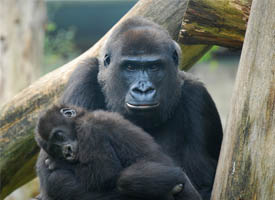 Zachary, a baby western lowland gorilla, was unveiled this week at Brookfield Zoo in suburban Chicago. The baby gorilla, born earlier this week, will spend the next four to six months in the arms of his mother, 11 year-old Kamba. After that, he will spend most of his days on Kamba’s back until learning to move on his own.
Zachary, a baby western lowland gorilla, was unveiled this week at Brookfield Zoo in suburban Chicago. The baby gorilla, born earlier this week, will spend the next four to six months in the arms of his mother, 11 year-old Kamba. After that, he will spend most of his days on Kamba’s back until learning to move on his own.
Zachary joins the more than 300 western lowland gorillas living in zoos across North America. Native to West Africa, the gorilla remains an endangered species due to hunting, habitat destruction and disease.
Learn more:
Read more about the birth of Zachary
Raw: Illinois Zoo Announces New Baby Gorilla (Associated Press on YouTube)
- Details
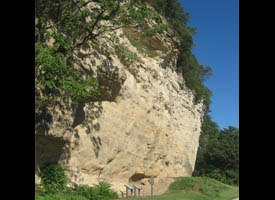 The Modoc Rock Shelter, located near the Missouri border in Southern Illinois, is a cut-out section of cliff overlooking the Mississippi River valley. The cliff was formed by ice age floods that carved through the land thousands of years ago.
The Modoc Rock Shelter, located near the Missouri border in Southern Illinois, is a cut-out section of cliff overlooking the Mississippi River valley. The cliff was formed by ice age floods that carved through the land thousands of years ago.
Archaeological discoveries by Irwin Peithmann in the 1950s found artifacts in the shelter that proved groups of people had been there as far back as 9,000 years ago. From Peithmann’s discoveries, it has been concluded that Native American hunters used the shelter as a safe area away from the elements. His excavations also have concluded different groups used the site as a long-term base camp around 6,000 years ago, and small hunting parties inhabited the area around 4,000 years ago. Hammer stones, bone awls and projectile points are just a few of the many discoveries found at the site.
It was declared a National Historic Landmark in 1961.
Learn more:
Visiting the Modoc Rock Shelter? Learn more about the site and plan your trip here
- Details
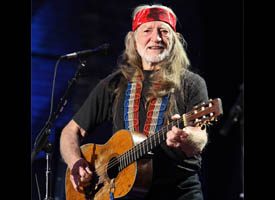 The first Farm Aid concert was held on this day in 1985 at Memorial Stadium in Champaign. The event, which attracted more than 80,000 people, was held to raise money for family farmers throughout the country who were struggling with drastically falling land prices and the rise of large corporate farms.
The first Farm Aid concert was held on this day in 1985 at Memorial Stadium in Champaign. The event, which attracted more than 80,000 people, was held to raise money for family farmers throughout the country who were struggling with drastically falling land prices and the rise of large corporate farms.
More than 100 musical acts performed at the event, including The Beach Boys, Bon Jovi, B.B. King, Bonnie Raitt and Willie Nelson. Nelson, along with John Mellencamp and Neil Young, were key organizers of the first Farm Aid. More than $9 million was raised during the event.
Since 1985, Farm Aid concerts have been held across the country. The New World Music Theater (now Hollywood Casino Amphitheatre) in Tinley Park hosted Farm Aid ’97 and ’98 as well as the 20th anniversary concert in 2005.
Over the weekend, the 30th anniversary concert was held at FirstMerit Bank Pavilion in Chicago, drawing nearly 30,000 concertgoers and hosting Dave Matthews, Imagine Dragons, Willie Nelson and Chicagoan Mavis Staples.
Learn more:
Read more about Farm Aid and the mission behind the concerts
More Articles …
- Did You Know? Emmy award winning actor Bill Murray is from Illinois
- Did You Know? Illinois was home to the nation’s most influential settlement house
- Did You Know? Illinois is home to America’s first planetarium
- Did You Know? Famous baritone saxophonist Hamiet Bluiett is from Illinois
- Did You Know? Jazz legend Miles Davis grew up in Illinois





